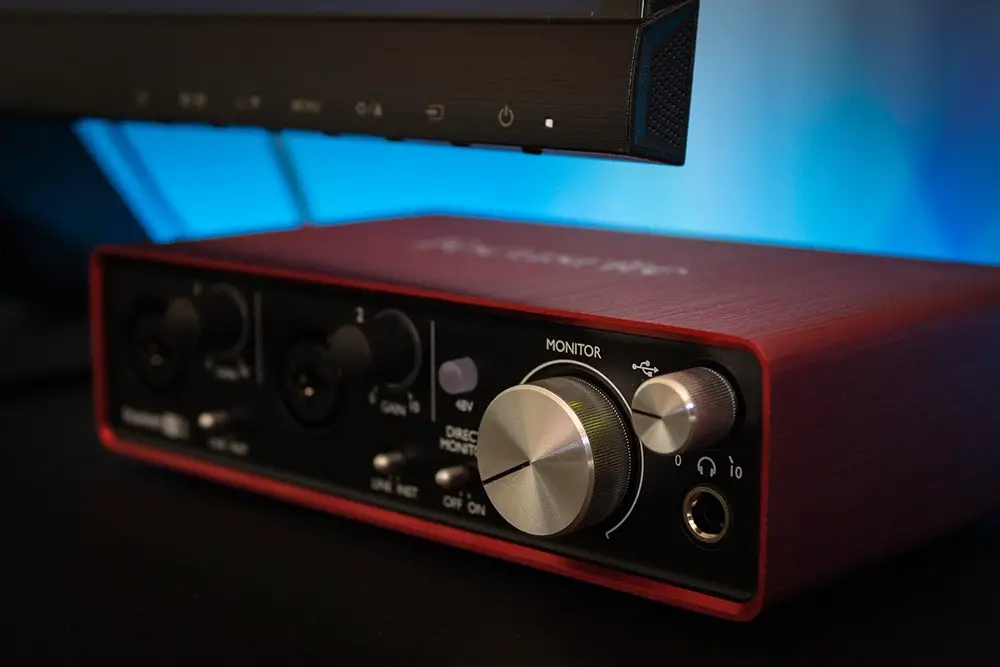
If you already have an audio interface, or maybe you’re looking at getting one, and you want to use it without having to attach it to a computer, you are in the right place. This article will guide you through situations where you may want audio to pass through without being processed by a computer and having latency added.
An audio interface can be used in a standalone mode without a computer if it has direct monitoring capability. In general, an audio interface needs a computer because it is designed to convert analog audio into a computer-ready digital format.
There are a few scenarios where you may want to use an audio interface without a computer, but an audio interface is overpriced for most use cases. You can probably get away with cheaper hardware. Let’s dive in.
Using An Audio Interface Without a Computer
Not everyone has the same definition of using an audio interface without a computer, so let me give the assumptions I’m working off of. No computer means the audio interface is not connected to a computer, phone, or any other device that can work as a recording device. The audio interface is operating in standalone mode, meaning it takes in an analog input and outputs in analog as well.
The desired purpose of using an audio interface in standalone mode is to make use of its internal amplifier or to combine several input channels into one output channel for use with an attached pair of monitor speakers.
It can be challenging to know if a specific audio interface will work without a computer. Some will, and some will not. Manufacturers don’t always make it clear if their audio interface will work as a standalone device, but here are some things you can look for in the specifications and user guides.
- Look for “Direct Monitoring”
Direct monitoring is where you are able to listen directly to your input signal after it has gone through the pre-amp stage and has been amplified enough that you can listen to the signal.
This signal is not fed through the Analog-to-Digital converter (ADC) and is not being sent off to the computer and back before you hear it.
- Look for the option to listen to the “Main” mix.
The main mix is an output signal that is designed to be sent to your main speakers. It will combine all your inputs into a single stereo mix.
A few audio interfaces are capable of feeding the input signal straight through to the main mix without having to send it to the computer.
The Caveat: Many audio interfaces require a computer to be connected and a digital handshake to be completed before performing any function. Unfortunately, I have never seen this documented. Manufacturers assume that the interface will be connected to a computer for recording or some sort of processing.
If it’s not meant for standalone use, it can be tough to know if it will work until you buy it and try it out yourself.
Here are a few that I know will work without a computer:
- Audient iD22
- Behringer UMC1820
- Focusrite 18i20
Will Focusrite Audio Interfaces Work Without a Computer?
I mentioned in the above list that one of the models would work, but they have a whole lineup of audio interfaces. So, what about the rest of them?
Focusrite Audio Interfaces can work standalone without a computer, starting with the Scarlett 6i6 model and up. Focusrite states that models without ADAT outputs can use Direct Monitoring to send an analog output, beginning with the 6i6. The Scarlett Solo, 2i2, and 4i4 must be connected to a computer.
“The following interfaces from each range can be used in standalone mode, without a computer:
Scarlett:
- Scarlett 6i6 1st/2nd Gen
- Scarlett 8i6 3rd Gen
- Scarlett 18i8 1st/2nd/3rd Gen
- Scarlett 18i20 1st/2nd/3rd Gen
Clarett:
- All Claretts can be used in standalone mode using the included power supply.
Red
- Red 4Pre
- Red 8Pre
- Red 16Line
Saffire:
- Pro 14
- Pro 24
- Pro 24 DSP
- Pro 26
- Pro 40
- Liquid Saffire 56
“
It’s not clear from the Focusrite documentation if the models with ADAT outputs will work with Direct monitoring. Here is what their support page says:
“These devices do not have ADAT Outputs, but can be set up to send their analogue inputs to their analogue outputs (i.e. Direct Monitoring) or to send either two channels or a Mix of channels over a SPDIF Output (if the interface has SPDIF):”
Source: https://support.focusrite.com/hc/en-gb/articles/115003394169
I have a smaller Scarlett 2i2 and don’t have access to the larger models, but from what I’ve heard, it is possible to use the larger models in direct monitor mode.
Alternative to an Audio Interface with No Computer
Most Audio Interfaces are software-dependent. They are designed to be connected to your computer, which has a software-controlled mixer and controls the interface.
Buy a Mixer
If you don’t need to record or have any plans to do so in the future, you would be better off buying a mixer with the same number as the interface you were considering. Mixers are designed to be standalone devices, whereas audio interfaces are primarily designed to send digital audio to be recorded.


